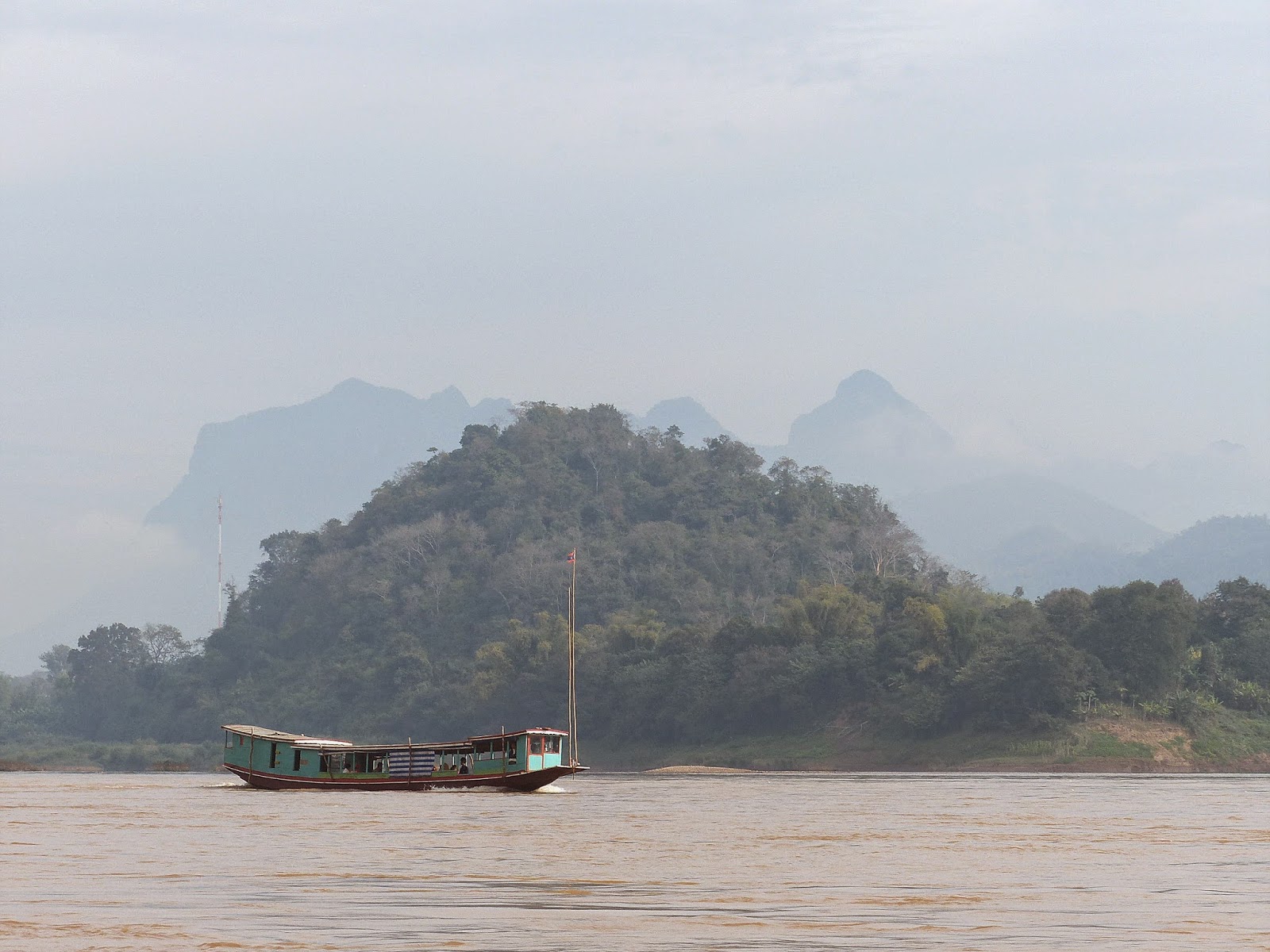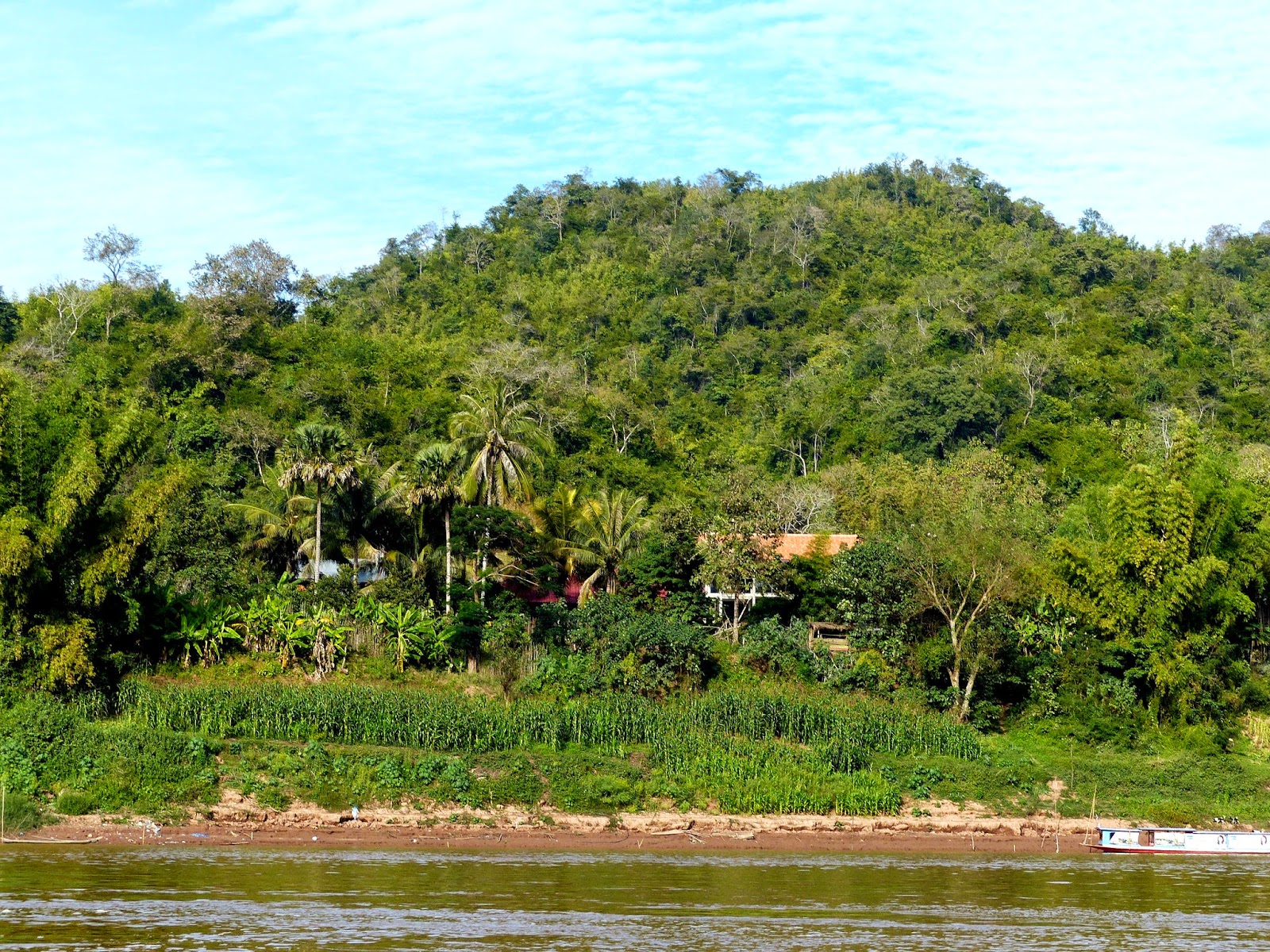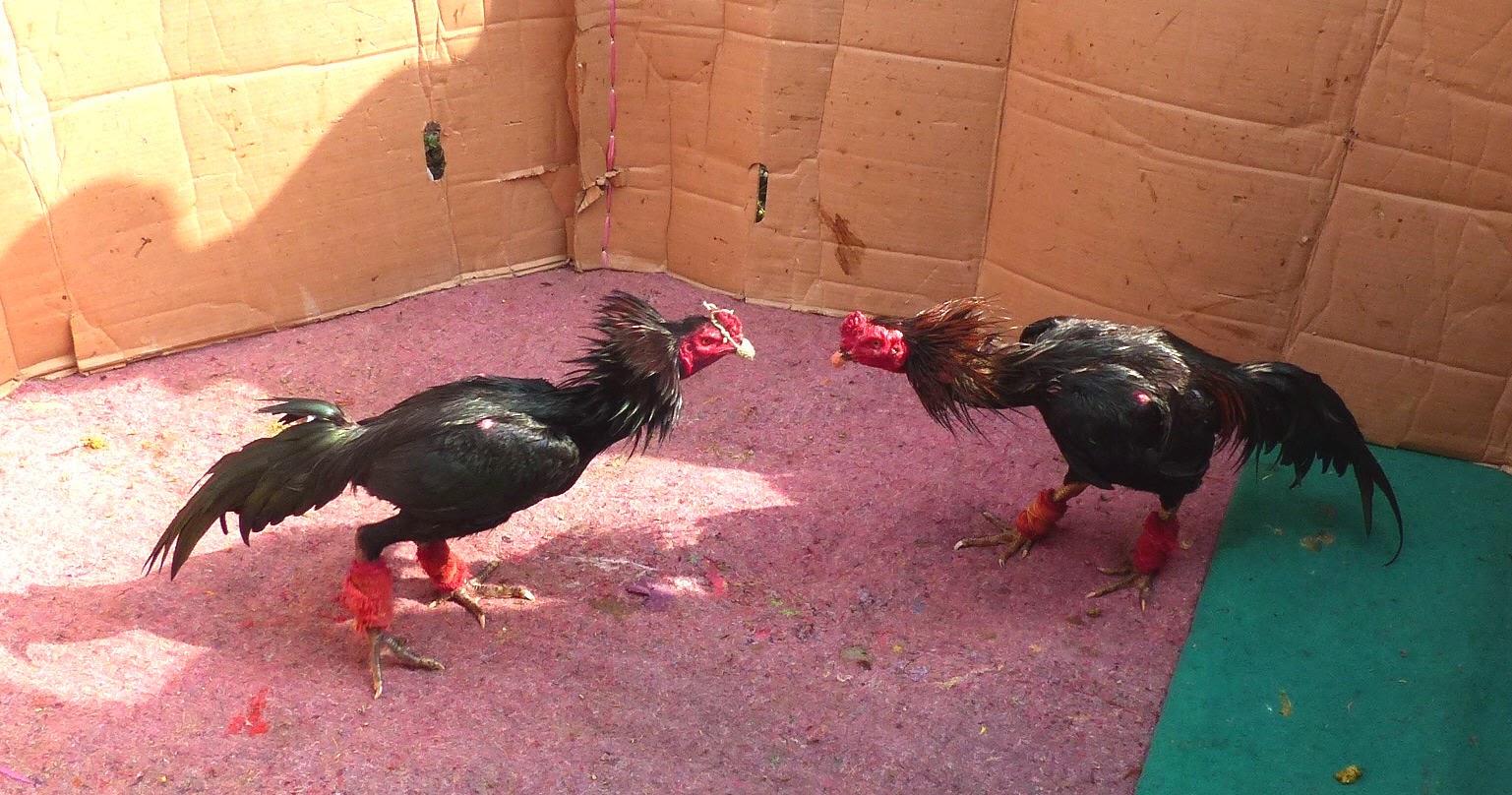to the village of Kompong Phluk, part of which is on stilts to survive flooding but the part we saw was entirely floating, the villagers living from fishing, selling to the floating restaurants on the lake and to the markets in town.
The next day we drove to Phnom Penh, the worst drive of our trip. The entire way was under construction, continuous pot holes, dust, traffic. We stopped about noon and sampled deep-fried spider and cricket.
I can't recommend spider, but cricket was not bad. Locals eat them as snacks while drinking beer and watching football on tv at tea houses.
In Phnom Pen, we visited the usual tourist sites: the National Museum, the Royal Palace, Wat Phnom (the city's eponymous temple), and the Silver Pagoda (its floor consists of 5329 silver tiles, most of which are covered in protective carpeting so visitors can't see or walk on them). In the middle of town, our guide pointed out giant fruit bats sleeping in tall trees above the traffic.
We took a ferry on the Mekong to Koh Dach island (also called "Silk Island") and watched locals spinning silk thread on primitive wheels and weaving silk cloth.
Deb contributed to the local economy by buying some nice silk table runners and a scarf.
In the evening, we flew to Vientiane, reportedly the most laidback capital in the world. Our guide took us to the Seasons Riverside hotel, a block or so from the high banks of the Mekong where we found a nice Lao supper at an on-the-street restaurant.
The next day, we visited Wat Si Saket, famous for its display of some 7000 Buddhas of all sizes, made from wood, ceramic, stone, and bronze from the 16th to 19th centuries.
We took in Ho Phra Keo, once the Lao royal family's personal chapel, and then on to other standard tourist attractions.
Interesting as the architecture was, I was most taken by the variety of sculpture decorating the structures,
including a huge reclining Buddha, representing his last moments on earth before achieving Nirvana.
You can get an idea of the size: Deb is standing in front by the umbrella. That evening we again ate on the bank of the Mekong.
In the morning, we took a 50-minute flight north to Luang Prabang, a World Heritage Site since 1995, located on a high peninsula between the Mekong and the Nam Khan rivers. For the first time, the temperatures (perhaps 60°F) suited our Oregon natures. The hotel clerk, on the other hand, wore a heavy coat and often a head scarf and complained. The population of Luang Prabang is about 50,000; its primary income is from tourists who come for the temples and other sights: it is full of boutique hotels and restaurants, souvenir shops and shops offering tours; it is the Estes Park of S.E. Asia. On the spit above the rivers, open air restaurants overlook the water. We munched Lao food and watched a fisherman cast his net and then beat the water to encourage fish to enter the net.
We visited Wat Zieng Thong, built by King Setthanthirath in 1559-1560, purported to be the most beautiful temple in S.E. Asia, the entrance guarded by fine Nagas.
Other temples were also lovely, with flowing roofs and walls decorated with inlays and gold.
Perhaps the most unusual was Wat Vison, built in the 16th century, referred to by locals as the Watermelon stupa.
In hopes of catching an interesting sunset, we climbed the 328 steps to the top of Phou Si, a hill in the middle of town.
Alas, the sky did not cooperate, but the view was nice.
We walked down a second route and came out on the main street with the ubiquitous night market already set up─a series of "easy-up" tents in the street with hawkers under them selling local craft and tourist crap.
Deb got up early to participate in the daily alms ceremony: Saffron robed monks and novices with their bowls each morning walk regular routes and collect food from the faithful and from tourists. If they collect more than they can consume that day, they share it with children who show up with their own containers. Workers in our hotel showed Deb where to kneel and laid out a rug.
She distributed rice, fruit, and cookies she had purchased from a local woman. Then we ate our own breakfast on the hotel patio.
We hired one of the traditional Mekong long boats and headed up the river, by temples and farmsteads. bamboo groves and forest, and beyond, mountains in the mist,
a land so peaceful and beautiful it breaks your heart to think of the boys and young men sent here to die by ignorant old men furthering their own political ambitions.
We put ashore at Xanghai village, known for production of a traditional Lao rice whiskey, Lao Khao, produced in pot stills that would make any moonshiner envious.
Although production is primarily for local consumption, the facility caters to tourists, of course, providing samples and a sign explaining the process.
Mr. Somboun also sold jars of the whiskey with various animals and herbs pickled within, each aimed at treating a particular ailment.
We toured the village and found a coming-out party, given when a baby is one month old; prior to that, it is kept inside for protection. Guests included the extended family, friends, and as it turned out, us. Gifts of money are accepted; Deb tied a ribbon on the baby's wrist signifying the money she had given.
As we continued upstream, we passed one of the long boats on the rocks. Our guide said the owner had loaded the boat so full of teak he could not effectively steer it.
The river is not benign. We were on it during the dry season. In the wet season it floods, and farmers move uphill until the water subsides. The restaurant where we ate lunch had a framed photo of a particularly bad year.
Our goal was about two hours upstream from Luang Prabang: the Pak Ou Caves,
renown for the hundreds of sculptures of Buddha arrayed on shelves and walls.
We boated across the river for lunch and had to tread a bouncy ramp since there was no dock.
After lunch we walked to the Nam Ou Elephant farm not far away where, since Deb had never ridden an elephant, we engaged one for a short ride into the forest.
The farm rescues elephants from Lao logging camps, brings them back to health, and keeps them in as natural a state a possible. For a fee, one can stay for up to a week (or probably as long as one wanted) to learn how to be a mahout.
A sign was posted explaining how to talk to elephants.
After our ride, Deb fed our elephant bananas, which she (the elephant) clearly enjoyed, skin and all.
We attended an operatic production of Phralak Phralam, the Lao version of Ramayana.
The complete work takes about 8 hours so is performed over five evenings.

We saw only part three, lasting about an hour and a half, with an orchestra of Lao instruments.
On our way to Kuang Si Falls, we found a group of men outside a roadside market comparing fighting cocks. Fighting cocks in Laos are valued and coddled; many Lao have one. (Our guide said he did.) The men had an exercise wheel to get their birds in shape.
They put two birds in a cardboard ring for a timed minute─one man had a stop watch. The birds' beaks were tied shut and cloth covered their spurs.
Trust me on this, for these photographs, no animals were harmed, or even fatigued.
We stopped at a Hmong village along the road, relocated from the mountains so health care and education can be provided
Hmong still maintain their hill farms, but (according to our guide) do not resist resettlement because they value the government services.
At one of their shops, Deb spun cotton on a Hmong wheel.
We visited a butterfly park, opened by a Dutch couple in January, 2014, guided by a Russian entomologist from Moscow who was visiting for a few months.
He showed us chrysalises that we never would have found without his help.
We visited a bear sanctuary; endangered Asiatic black bears rescued from poachers and from bear bile collectors who keep the bears in cages to extract bile for Chinese remedies.
Our goal was Kuang Si Falls, about 19 miles south of Luang Prabang: lovely cascades and turquoise pools.
We were ready to move on, but problems arose. (More in Part Three.)
























































No comments:
Post a Comment